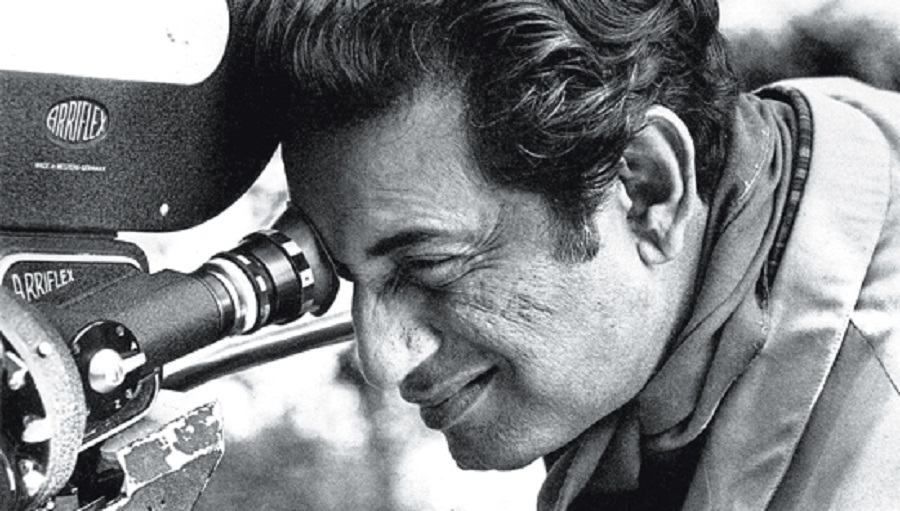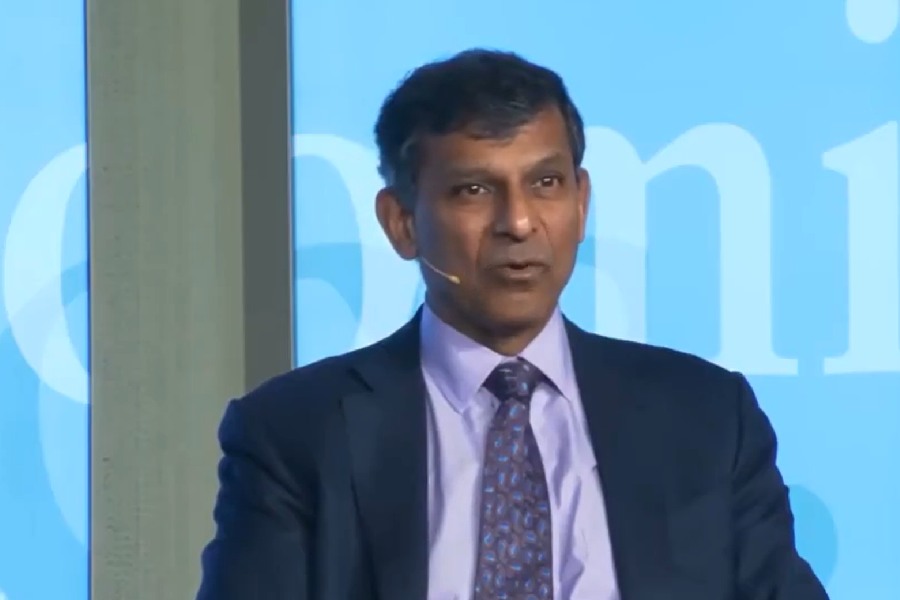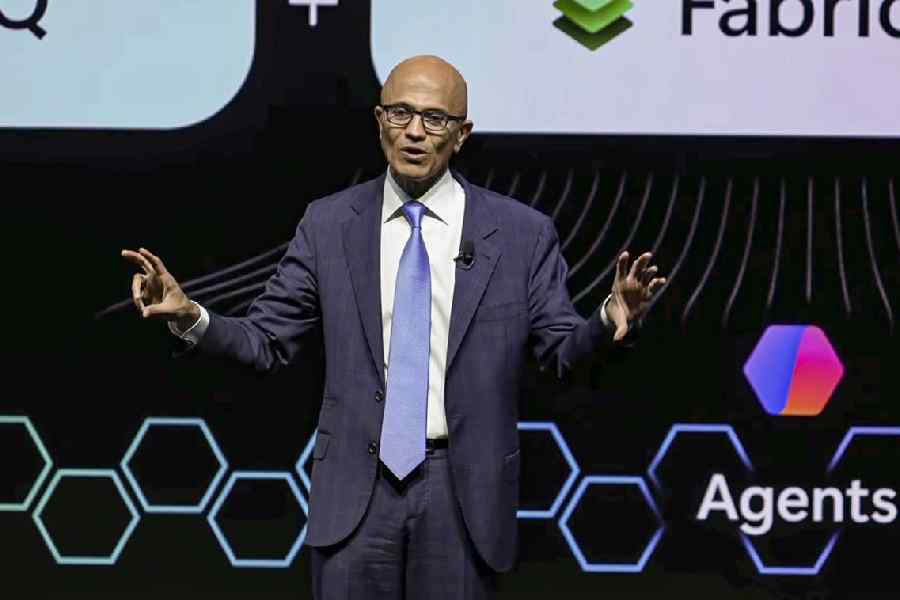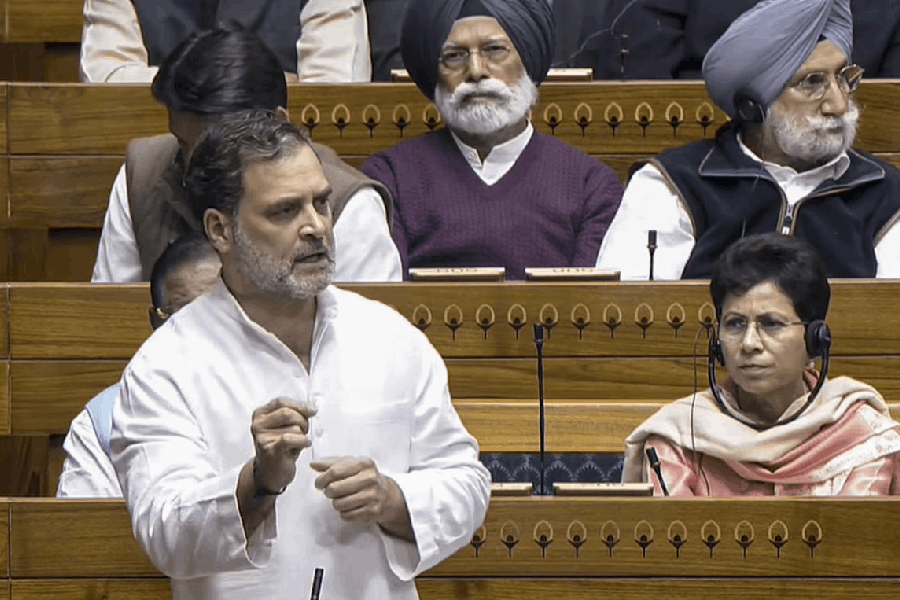Ray — an anthology of four short films based on auteur Satyajit Ray’s much-celebrated short stories — will make its way to Netflix on June 25. Abhishek Chaubey, the man behind films like Ishqiya, Udta Punjab and Sonchiriya, adapts Ray’s Barin Bhowmik’s Ailment to make Hungama Hai Kyon Barpa (starring Manoj Bajpayee and Gajraj Rao), while Vasan Bala, the director of the quirky Mard Ko Dard Nahi Hota, adapts Ray’s Spotlight into a short called Spotlight (starring Harshvarrdhan Kapoor, Radhika Madan, Chandan Roy Sanyal and Akansha Ranjan Kapoor). Srijit Mukherji takes on the task of adapting two of Ray’s shorts — Bahrupiya (Kay Kay Menon, Bidita Bag and Dibyendu Bhattacharya) based on Bahuroopi, and Bipin Choudhurir Smritibhram into Forget Me Not (Ali Fazal, Shweta Basu Prasad and Anindita Bose).
With the trailer of Ray dropping today, The Telegraph caught up for an exclusive chat with directors Srijit Mukherji, Abhishek Chaubey and Vasan Bala on the anthology, their earliest memories of Ray and the influence of the master on their craft.
What was the genesis of Ray?
Vasan Bala: Sayantan Mukherjee, who is the creator of the show, reached out, and there were a couple of short stories that he had shared. The first time when he mentioned it, it seemed like a great opportunity to me. I told myself, ‘Let me just jump in, take hold of this opportunity and make something’. That’s how simple it was.
Abhishek Chaubey: When Sayantan came and told me that there was a plan to do an adaptation of (Satyajit) Ray’s short stories, my first reaction was, ‘Finally!’ It’s something that I have been talking to people about over the years... that we should do something based on Ray’s short stories. I was thrilled at the opportunity, and then there was just the question of selecting the right one.
What made you pick the ones that you did?
Srijit Mukherji: In this anthology, we are projecting these stories in a much, much darker space than they were written in. The USP of the series is that the original stories were written for Young Adults, but our adaptations have gained in darkness and the final impact is much more adult, and almost in a Black Mirror kind of space. In that zone, I thought Bipin Choudhurir Smritibhram, which is called Forget Me Not in the anthology, lent itself to quite a mind-wrecking, almost nerve-wrangling end. It’s not there in the original story, but we have taken it there. It’s applicable to all four stories in the anthology.

Ali Fazal in Forget Me Not, directed by Srijit Mukherji Sourced by the correspondent
The other story I have directed is Bahrupiya, based on Ray’s Bahuroopi. It’s chilling and quite dark in itself, but we have taken it a notch higher.

Kay Kay Menon in Bahrupiya, directed by Srijit Mukherji Sourced by the correspondent
Abhishek: I had read Indigo (Neel Atanka) and some other short stories written by Ray babu. Somehow, I missed this story. The reason why I liked Barin Bhowmik’s Ailment (on which Abhishek’s Hungama Hai Kyon Barpa is based) was for the simple reason that most of Ray’s stories that I have read have an element of the sinister, the surreal, the macabre, and what very often gets missed in the reading of those stories is that he has his tongue firmly in his cheek... he’s got a great sense of humour, and his stories are peppered with that. But somehow, that gets lost. I found this story very funny and quite character-driven, with situational humour as well as character-driven humour and I thought that would translate very well into a unique adaptation.

Manoj Bajpayee and Gajraj Rao in Hungama Hai Kyon Barpa , directed by Abhishek Chaubey Sourced by the correspondent
Vasan: I think Abhishek touched upon a very important point. Humour is something that people don’t equate with Ray’s short stories at the get-go, but it’s a huge aspect of all his works. There is, of course, the drama and the emotions, but humour also plays a very important role. For me, Spotlight (based on Ray’s Spotlight) was a great opportunity because as a film-maker, you always want to make a film about films, about actors and artistes and their vanity and insecurities. There’s always that one story that you want to say, and Spotlight became that story for me because I wanted to delve into that world and also because Ray had laid out the blueprint of the conflict, with the potential for humour, so well in this story.

Radhika Madan and Harshvarrdhan Kapoor in Spotlight, directed by Vasan Bala Sourced by the correspondent
Did you treat your respective stories as part of an anthology or was the focus on making them independent identities?
Vasan: They are separate but because they are all written by Ray, somehow thematically it comes together, even though the voices and the expressions are all completely different. I haven’t seen the other films but one gets a sense of how mindset and psychology has been explored in a similar vein in all the films.

Vasan Bala

Humour is something that people don’t equate with Ray’s short stories at the get-go, but it’s a huge aspect of all his works. There is, of course, the drama and the emotions, but humour also plays a very important role
VASAN BALA
Abhishek: The common link between all the stories is the psychological exploration of the characters. We are happy that we got to work on different genres in the same anthology. It makes for a very full meal.
What’s your earliest memory of watching a Satyajit Ray film or reading a literary piece written by him?
Srijit: When I was around six or seven, I first read Ray in a short story collection, before I read his more famous Feluda or Shonku. It was his Ek Dojon Goppo and the first story I read in it was Septopaser Khide. The first film of his which I watched was Goopy Gyne Bagha Byne. And needless to say, both the story and the film left an everlasting impact on me.
Vasan: Likewise, the first film I saw, thanks to Doordarshan, was Goopy Gyne Bagha Byne. The music, the look and feel... it was fantasy, so at that age, it made a huge impression on me.
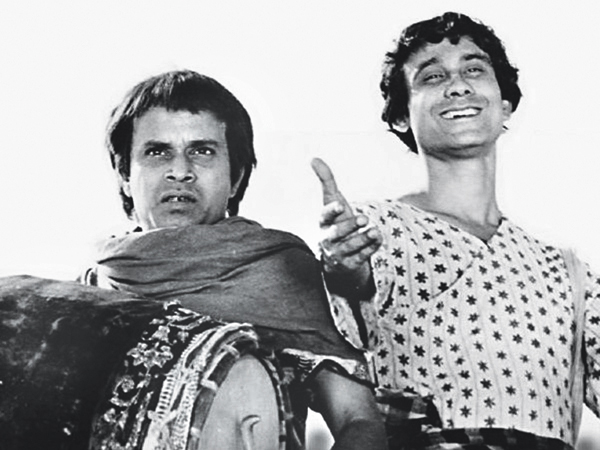
Goopy Gyne Bagha Byne
Abhishek: As a child, I lived in Ranchi in a colony where there were many Bengali families. I remember there was a fever of excitement because Doordarshan was showing Goopy Gyne Bagha Byne. I saw his other films when I went to college, and that’s when I read his stories as well.
Which piece of Ray’s work has had the most profound impact on you?
Srijit: For me, it has been Nayak. I started my career with Autograph, which is a kind of tribute to Nayak. It’s like a film within a film. I think Nayak, in many ways, is an underrated film of Ray’s. People don’t speak of it in the same reverential tone they use for the Apu trilogy or even Charulata and the other classics. For me, Nayak is the perfect amalgamation of the two very unique and distinct faces of the Bengali film industry — one, the international, the niche, the eclectic and the other, the more mainstream and commercial. The film looks at not only the film industry, but also at the various socio-economic strata and their representatives, human frailties.... There is humour, pathos, reflection, and everything comes together in an overnight journey. The hint of a romantic relationship is so beautifully and subtly dealt with. It’s not really a road movie with romance thrown in, but there is a hint of so many genres in this remarkable concoction of a film. A lot of Nayak’s appeal is, of course, also due to the presence of the matinee idol Uttam Kumar, but overall, I think it’s the most impactful film. So much so that there was a time during my university days when we would converse only using Nayak dialogues!
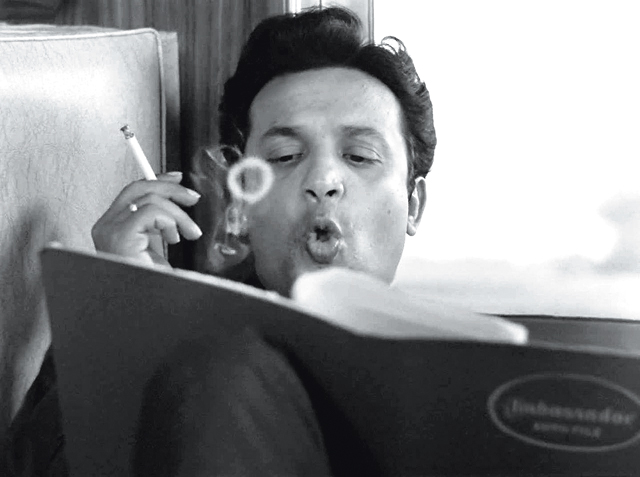
Nayak
Vasan: Initially, it was Nayak for me as well. But later, I strayed into Aranyer Din Ratri, and stayed with it for a while. I think because I was just graduating at that time and there would be those aimless afternoons... one friend would have a vehicle and we would all piggyback and go on these really directionless adventures. Somehow that stayed with me, this journey of these four guys who venture into the jungle. It’s not an adventure film, in that sense, it’s a very contained kind of adventure.... In a very strange way, the film affects me... their journey, the people they meet, the power structure, the sense of entitlement. This film stays with me even now.

Aranyer Din Ratri
Abhishek: It keeps changing in my case because Ray has such a wide oeuvre. There are so many films that we love so much! Of late, I have been thinking a lot about Mahanagar and Pratidwandi. I was thinking of Pratidwandi the other day and the young man’s rage that is there in the film.
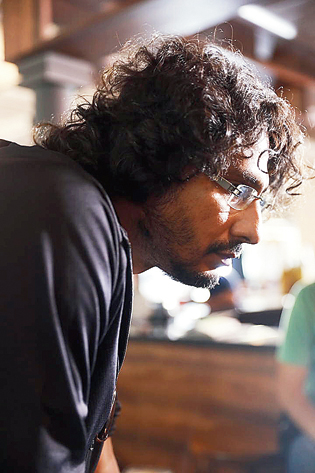
Abhishek Chaubey

Of late, I have been thinking a lot about Mahanagar and Pratidwandi. I was thinking of Pratidwandi the other day and the young man’s rage that is there in the film. It’s unlike him to talk like that, but see how relevant it is today... we are almost going through the same thing today
ABHISHEK CHAUBEY
It’s unlike him to talk like that, but see how relevant it is today... we are almost going through the same thing today. But my Ray choices keep changing... I don’t know what mood I will be in six months from now. I will probably pick Charulata or something else (smiles).

Mahanagar
Is there anything from his style or storytelling that has consciously or subliminally made its way into your craft?
Abhishek: I find it hard to think of Ray in the way I think of a foreign film-maker who I love. Ray is our own, the world that we see in his films is the world we know. I look at him with reverence, but also with a lot of affection, whereas I would probably look at somebody like (Ingmar) Bergman with a lot of awe and admiration and respect. Ray’s music, the performances that he drew, are awe-inspiring, but first and foremost, what I feel for him and his craft is warmth and affection.
Srijit: For me, it’s the other way round. In the sense, I don’t try to imbibe anything consciously because it’s very difficult to be a storyteller in Bengal and not have an overreaching influence of Ray (laughs). But if I had to name elements, then I would definitely begin with the brevity of dialogue... the impact of his dialogue writing is one of the best I have seen.... With him, ‘the very best in India’ doesn’t apply, it’s always ‘the very best in the world’... his arena is different. Say when he is getting a Golden Lion in Venice, he’s up against the very best... the likes of (Akira) Kurosawa and (Luchino) Visconti. He’s always competed in the arena of the world. His dialogue, his scenario writing, his musical treatment, his editing, his storytelling, his handling of characters, his handling of drama is in a different league. Whenever I write, I always remember what he used to say about brevity, about economy of expression....
He used to talk about the background score being absolutely supplementary. In the sense that if you can do without it, you are better off. In fact, if you can even do without dialogue, you are better off. As a visual medium, he believed that cinema should be that powerful that you are able to convey emotions without using any of these supplementary crutches. When I write, these thoughts automatically have a clamping down effect, which kind of helps to get rid of storytelling excesses in terms of cinematic fat quite naturally. That’s one big lesson that keeps reiterating in my mind. That doesn’t necessarily come from just watching his films... it also comes from reading a lot of his work on films, as in his books on films. In them, he makes it very clear what constitutes good storytelling and good film-making for him.
He is the master, and when he sets down certain rules — even though it may be looked upon as subjective — more often than not, the path that he showed is really worth travelling on for any storyteller.
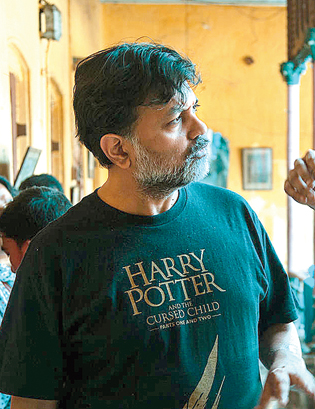
Srijit Mukherji

With him, ‘the very best in India’ doesn’t apply, it’s always ‘the very best in the world’... his arena is different. Say when he is getting a Golden Lion in Venice, he’s up against the very best... the likes of (Akira) Kurosawa and (Luchino) Visconti. He’s always competed in the arena of the world
SRIJIT MUKHERJI
Vasan: We are all evolving with our lives and the films we are trying to make. For me, it was the style when it came to Ray. Whether it was Uttam Kumar wearing sunglasses or Dhritiman Chaterji walking the streets of Calcutta.
Then, I moved on to the concepts of family and food and the element of warmth in his films, with which he drew in the viewer. I am at that phase of my life where I am exploring and understanding that part of film-making. It could be a village, a middle-class home or an upper-class home... the way he domestically engulfs you in his story and his characters through food and people having conversations over food... I am trying to understand that more, and I would be happy if some of that percolates into the stories I am trying to tell.
Any film show reel made anywhere in the world will, in all probability, have a Satyajit Ray frame making its way into it. Will it be fair to ask you to pick a favourite?
Srijit: Selecting a favourite film of his is a task for me and I still haven’t made my Top 10 and you have broken it down into a frame! (Laughs) I would say Nayak, the entire film (laughs), a major part of the Apu trilogy... in Apur Sansar, it would have to be the final walk, with Kajal on Apu’s (Soumitra Chatterjee) shoulder. In the same film, there is the scene with the cigarette with Aparna (Sharmila Tagore). There is the very famous tight close-up of Apu from Pather Panchali which finds its way into most collections... that is used a lot. There are two reflection frames that are memorable — one the moustache scene in Pather Panchali, and then in Abhijan with Soumitra Chatterjee. The Charulata sequence on the swing is unforgettable. And then the final scene of the film which takes Charulata away from Nastanirh (the Rabindranath Tagore novella on which the film is based) and gives it an identity of its own. There are so many... Aranyer Din Ratri, Goopy Gyne Bagha Byne.... It’s a needle-in-a-haystack question!
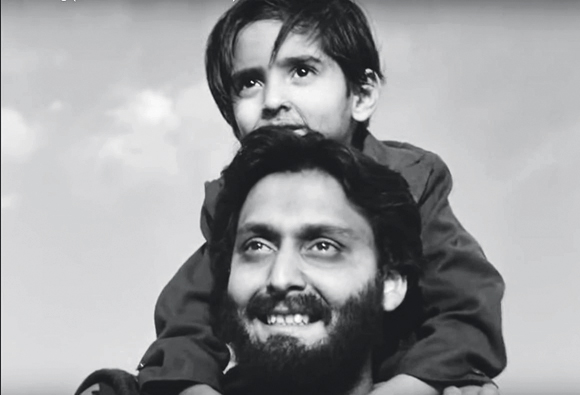
Apur Sansar
Vasan: All the mirror shots, for sure. As a south Indian, I first discovered Mani Ratnam and then subsequently realised that there is so much of Ray in Mani Ratnam. The mirror shots speak to me. If I had to pick one, I would mention the lipstick-wearing scene in the washroom in Mahanagar.
Abhishek: It is a very difficult question and thanks to Srijit for having picked so many!
Srijit: First-mover advantage!
Abhishek: The thing about Ray is that you may sometimes think that he is conservative in terms of his lensing and camera, and then he will surprise you with something that’s stylistically so ahead of its time. The Mahanagar image is, of course, iconic and so is the opening scene of Charulata. Charulata, in terms of design, is a very, very superior film. Everything is carefully constructed and is absolutely gorgeous to look at. In Kapurush, there is a close shot of a cigarette... there’s a wide-angle lens and they are out on a picnic or something... and the cigarette slowly extinguishes in the foreground while something is happening in the background. It’s the kind of frame that a maverick photographer in the 2000s would shoot, and Ray did that in the 1960s!
Ray, as you mentioned, was way ahead of his time and will always remain relevant. If each of you had to pick a Ray film to introduce to someone of this generation who hasn’t watched or read him, which would it be?
Abhishek: If the person is interested in cinema, then he can pick anything by Ray, especially the work that he did in the first 20 years. But for someone for whom movies isn’t the first love, I would actually ask them to read Ray first. That’s a great way to get into his head.
Srijit: Ray, frankly, has everything in his oeuvre. For someone who loves literature, I would ask him to go in for adaptations like the Apu trilogy, Charulata or even Jana Aranya, for that matter. Jana Aranya is not spoken of in the same reverential tone as his other films, but I think it’s a brilliant film. Or Seemabaddha, which is another favourite film of mine. If it’s a child, then it has to be Goopy Gyne Bagha Byne or one of the Feluda adventures. I would go for Sonar Kella more than Joy Baba Felunath, but even the latter, especially for Maganlal Meghraj.
Vasan: My daughter just turned four, and so I will first show her Goopy Gyne Bagha Byne, followed by Joy Baba Felunath and Sonar Kella. We grew up in a generation which consumed cinema in extreme poor quality on VHS, but loved it even in that format. It will be interesting to see how the generation of today consumes these classics.
Signing off with your anthology, safe to say there will be more because Ray’s oeuvre is unending?
Srijit: I am rooting for more adaptations. I have, in fact, requested Netflix. There is a huge treasure trove of Ray’s stories and there are some fascinating stories to be told and adapted in a more interesting space in 2021. If we get the necessary permissions to do those stories, it will be fantastic!
Which is your favourite Satyajit Ray short story?
Tell t2@abp.in

